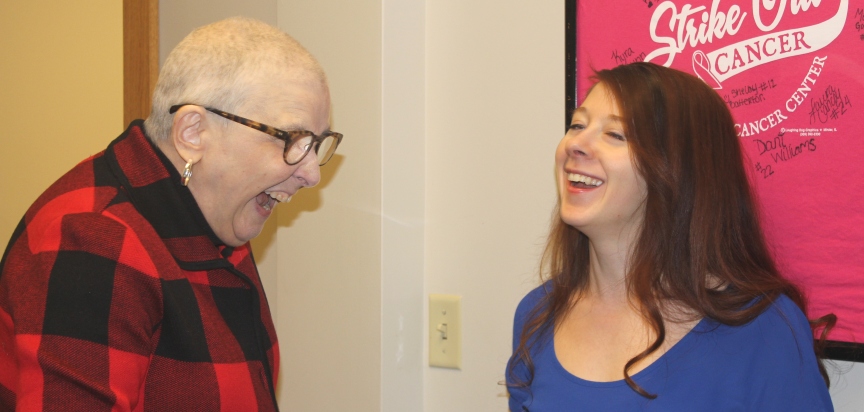It was a little like being in The Twilight Zone.
Breast cancer survivor Susan Owens was watching M.F.A. student Natalie Blackman portray her, reliving laying on a table for a biopsy, being wrapped in a strange peace, and eventually laughing about a breast implant that popped out of an incision, comparing it to an alien eyeball.
“I was on a high and couldn’t go to sleep afterwards,” said Owens, a School of Communication faculty member, the day after the performance this week at the Community Cancer Center in Normal.
The two were paired as part of an outreach program where M.F.A. theatre students look for ways to engage with the community. Eight students were matched with those affected by cancer. After taping interviews with them, the actors created dramatic 3-minute stories for a string of performances called The Hope Monologues. It’s called “verbatim theatre,” explained Kevin Rich, artistic director of the Illinois Shakespeare Festival, who teaches the actors. The story is told in the patient’s exact words; the pauses, the ums, a giggle or a difficult moment are all captured.
The monologues were performed during the cancer center’s dedication of the Wall of Hope, a project featuring 108 works of art created by cancer patients and their families. Illinois State art and design students assisted in the project, which involved those ages 3 to 86.

Community Cancer Center chaplain Cheryl Peterson-Karlan and three M.F.A. students at the Wall of Hope unveiling this week.
The center’s chaplain, the Rev. Cheryl Peterson-Karlan, said the idea for the monologues came at the last hour, as she started hearing the stories behind the paintings.
“There was such power to the stories,” she said. “It’s one thing to look at the beauty of the paintings, but as I talked to people about the stories, they were so touching.”
And that’s when she walked to Janet Wilson, director of the School of Theatre and Dance, who had the idea of weaving the stories into a theatrical piece. From there, Rich took on the project, allowing each student to create a one-person show.
“Everyone from ISU has been awesome,” the chaplain said. “It’s been quite a process to see it unfold. There is a real healing power in the arts, and the willingness of the ISU arts community to commit to finding ways to engage here at the Community Cancer Center has really helped. There is a piece to their mission and ours that we hold in common, and it’s been wonderful to share.”
Although Owens agreed to tell her story, the others will remain anonymous. The Hope Monologues may be performed again. The Wall of Hope is permanently displayed in a hallway leading to the medical oncology area, but a smaller traveling display is being prepared.
“We’re hoping somehow the performances can live on,” Rich said.
Actor Joey Banks portrayed a man who reconnected with his childhood sweetheart after 35 years, only to watch her struggle through cancer. On the nights she wasn’t breathing well, he’d stay up and watch over her, listening for any changes.
Banks said he was struck by the “absolute selflessness that is present in all of us. For this man, it isn’t that he simply takes care of his wife, but he lives for her.”
Owens plans on staying in touch with her acting student.
“I’m sure we’ll stay connected forever,” she said. “She and I just bonded. We are kindred spirits.”
Blackman was also changed by the experience, saying the story was a more powerful script than any she could have found.
“I just got this joy from her,” she said. “It has deepened my own sense of being alive. She taught me that no matter what, if you look for it, hope is always there. Always.”
Kate Arthur can be reached at kaarthu@IllinoisState.edu.


